



Introduced: 1993 (FA-2/FB-2), 2000 (FA-1/FB-1), 2002 (revised FA-2/FB-2), and 2024 (Atlas FA-1/FB-1)
These models are all pretty different, but since they're all Alco cab units I'm going to save myself a bit of time and cover them all here. Note that for a brief period of time (during the 1970's) Life-Like also imported (in Life-Like packaging) the old Mehano/Yugoslavia FA-2. However, those models (being primarily associated with MRC and Model Power) have nothing in common with any of these Chinese-made models and are covered elsewhere in this encyclopedia.
Life-Like's 1993 FA-2/FB-2 models (pictured above) were the fifth in a series of nice looking, decent running and (most importantly) affordably priced Life-Like locomotive models (all manufactured in China). Throughout the 1990s, the same basic chassis design employed in these models would eventually be recycled (more or less) in numerous other "wallet friendly" Life-Like models - GP38-2, F7, F40PH, BL2, and GP18. It was a good niche for Life-Like at the time - filling the void between Bachmann's line of cheapie trainset junk and the nice-but-expensive offerings from Atlas and Kato.
Like the rest of Life-Like's early line of N scale locomotives, these models were also sold in Moki/Micro Ace packaging (and presumably not for the North American market) -
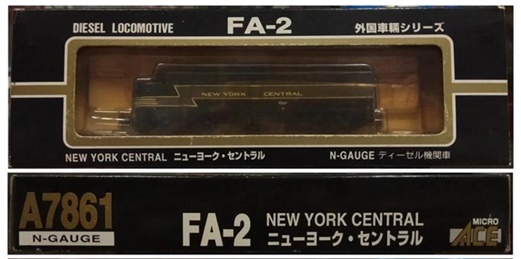
The chassis is all plastic and quite light. Ala-carte weights plunked atop each of the truck towers provide most of the model's weight. The motor is an open-sided, skew-wound, 5-poler. All four axles are geared and all eight wheels provide pickup (no traction tires). Current is transferred from the trucks to the motor via miles of wiring (two wires per truck). Apart from the brass worms, all the gearing is plastic. The driveshafts are plastic with springs in the middle. Couplers are truck-mounted Rapidos (open pilots). The wheels are blackened. They're also low-profile, so no problems on Code-55 track. A non-directional headlight is wired to the motor and sits atop the forward weight.
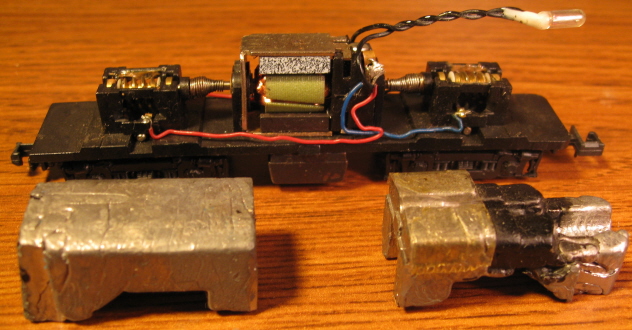
Now, I'm not going to blow smoke up your skirt and try to tell you that these models are even in the same ballpark as an Atlas or a Kato (either in looks or performance). But for what they were (affordable), they're quite respectable. They're not noisy, throttle response is smooth, pulling power is good, pickup is great (no stalls), and slow-speed creep is nice (although the top-end speed is off the charts). Shell detailing and paint aren't terribly fine, but for what they cost (about a third the cost of an Atlas or Kato model of that era), they were a good value (especially as compared to the godawful offerings from Bachmann and the like).
Ironically, these models employ virtually the same chassis/mechanism design used by Model Power/Mehano in some of their late 1980s diesel models (C-420, et al). Not surprisingly, performance is quite similar.
The "B" units are dummies (although they use the same exact chassis as the "A" units - right down to the gearing) -

Although the A's and B's share the same chassis, a B shell will not simply plunk down onto an A mechanism (in order to make a powered B). To do this, you would first have to modify (shorten) the forward weight on the powered mechanism.
Trivia - Brawa was the European distributor for these models back in the 90's -
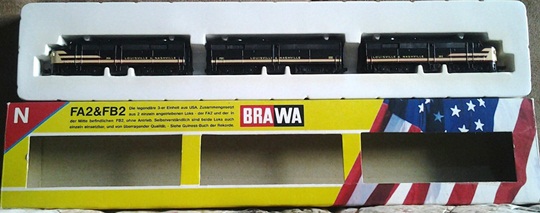
By the end of the 1990s, Life-Like had started dropping all of their wallet-friendly locomotive models in favor of higher-end offerings. In 2000, they released these all-new FA-1/FB-1 models -
Both the A and B units are powered. The fine detailing and paint on these models is exceptional, and definitely a brave new world for Life-Like. Oh sure, I've heard some grumbling about the fact that the number boards are wrong for the UP versions, but I guess you can't please everybody.
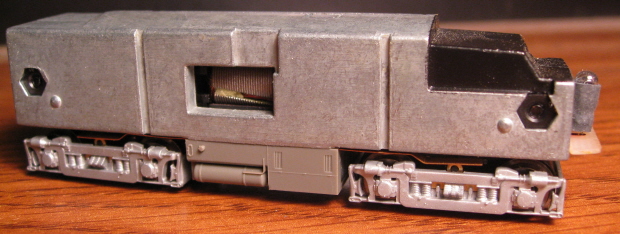
The mechanism has most of the modern niceties - The chasis is all-metal and split-frame. The current collection scheme is of the "low-friction" ilk. The motor is an open-sided, skew-wound 5-poler (spinning dual flywheels). All wheels are geared and provide pickup (no traction tires). All gearing is plastic. Wheels are blackened and low-profile (no problems on Code 55 rails). Couplers are shell-mounted. The pilot coupler is a knuckle, whereas the rest are Rapidos (and easily swapped out for MT's). A non-directional headlight is mounted to a small PC board on the front of the chassis (unfortunately, it uses a filament bulb rather than an LED). Also unfortunate is the complete lack of support for DCC.
These models run extremely well - great pickup, great throttle response, great slow-speed creep, exceptional pulling power, etc. The top-end speed on these models is very reasonable (Life-Like having gone the "slow speed motor" route years before Atlas). My only complaint is that most (or all) of the first-run models make a bit more noise than we'd like to see nowadays. Out of the box they're almost "electric razor" loud. And although they do quiet down after a bit of running, they never quite lose that buzzing whine. I'm not sure what causes the racket or what one might do to address it, but it's certainly not a deal breaker. And fortunately, I guess Life-Like figured out the problem somewhere along the line. My more recent FA-1's and FB-1's run extremely quietly, and with none of the buzzing of my first-run models.
In 2002, Life-Like issued completely redesigned FA-2/FB-2 models -
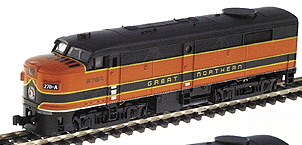
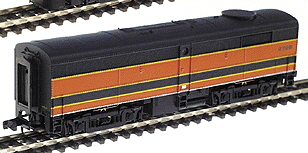
As with their FA/B-1 models, both A and B units are powered. And although the new shells follow the same basic contours of the previous FA/B-2 models, the similarities pretty much end there. The detailing and paint on these new models is quite sublime.
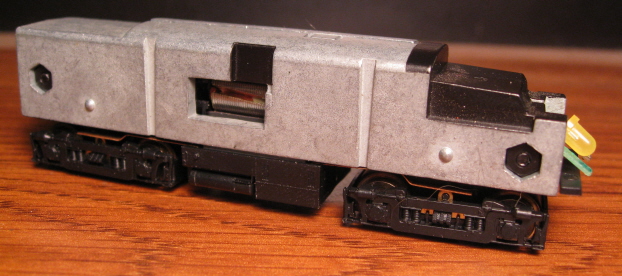
The chassis/mechanism is basically identical to the one used in the 2000 FA/B-1 models (albeit a bit longer, ala the prototype). The good news is that the non-directional filament headlight bulb has been replaced by a directional LED. And the really good news is that all of these models run whisper-quiet right out of the box. Whatever the problem was that caused all the racket in the early FA/B-1 models has been fixed here. Consequently, these models are flawless performers in all respects.
Atlas purchased the Walthers / Life-Like line of N scale models in 2018 and reissued the FA-1/FB-1 as part of their "Master" line in 2024 -

Although the chassis was modified to support DCC Sound, shells can be freely swapped between the old and new versions. The chassis was modified to accept a PC board up top (sandwiched between the chassis halves old school style). Contacts on the board receive current from the chassis halves. A Next18 DCC interface is provided on the back end of the board. Wires from the main PCB transfer current to a redesigned PCB on the front of the chassis. LEDs provide directional lighting for the headlight and number boards (said number boards are controlled by F6 on decoder-equipped models). Metal contacts brush up against the bottom of the main PCB and transfer current to the motor and speaker. The truck contact strips are screwed to the chassis (as opposed to being sandwiched between the fuel tank and chassis). Lastly (and inexplicably), openings were added to the sides of the chassis where the flywheels sit.
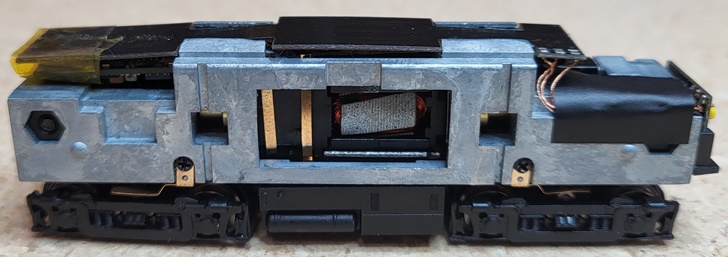
The trucks and fuel tank are unchanged from the previous version. The speaker mounts inside the bottom of the chassis, held in place by the fuel tank -

Performance on this new version is pretty much identical to the previous version (IE, excellent), however it may take some preemptory tweaking to get there. Out the box, mine had a lot of pickup problems (particularly evident at slow speeds). What I wound up having to do was pull the trucks off and scrub the wheel blackening crud off the wheel surfaces. I also had to take the trucks apart to access the axles and axle cups in the wipers (all of which were also slathered in blackening). Once all that was cleaned up, it ran around at slow speeds without a hitch. Next, I had to lubricate the gears in mine to quiet things down. As delivered, there is no lubrication, and the end result is a bit of a buzzy whine as it rolls along. So, some annoying maintenance there, but nothing that the average modeler shouldn't be able to handle. The saving grace is that the trucks are not wired to the chassis (unlike every other sound-equipped Atlas loco of similar vintage).
Atlas Features -
- Accurate lettering and crisp detailing
- Powerful motor
- Finely detailed body
- Durable metal wheels
- Directional LEDs (Where appropriate)
DCC Features ("Gold" models) -
- Supports all DCC-programming modes
- DCC includes RailCom and RailComPlus, with 14, 28 or 128 speed steps and with 2-digit or 4-digit addressing
- Flexible mapping of function keys F0 to F28
- A total of 6 DCC function outputs are available, and all can be function mapped (disable, brightness, light effects) individually
- Follows all NMRA DCC standards and recommended practices
- Over 20 sound effects, including engine start-up and shutdown, prime mover sounds through all eight notches, bell, air horn, air compressor, dynamic brakes and more
- Up to 16 user-selectable horns, 2 user-selectable bells, and 2 user-selectable synchronized brake squeals
- Equipped with ESU’s Exclusive "Full Throttle" feature for ultimate realism in prototype running
Shell Removal -
To free the shell dimples from the chassis bumps, simply spread the shell sides apart and lift.
Grades: B (for the first FA-2/FB-2), and A (for all the rest)
First version FA-2/FB-2 reviewed: 5/93 Rail Model Journal, 5/93 Railroad Model Craftsman, 3/93 Model Railroader ("Life-Like's N scale model is made in China. Its dimensions and details check out well compared to the drawings in Alco FA-2. An attempt was made in the tooling to represent the braces behind the screening, but the effect works in only a few places. Our samples were nicely painted and lettered. According to Life-Like's Bill Moore, all the schemes and numbers used are authentic... Inside is a plastic frame and two large, soft-metal weights that fill the body cavity. The motor is a double-ended, open-frame type with a five-pole, skewed armature. The drive shafts are springs... The trucks are pinned in place through a slot in the gear tower, and this is where I discovered a design problem. The pins are simply too short and will disengage if they work even a bit to either side. My engine ran poorly until I discovered this was caused by one pin that wasn't centered. Once properly centered, the pins should stay put... The wheels checked out nicely... All the wheels are driven and pick up current, which is conducted to the motor via small wires. The B unit has the same frame as the A unit, minus the motor and drive system. All you have to do to make a powered B is remove the shell from an A unit, trim a little metall off one weight, and snap on the B-unit body. The FA-2's crawl speed isn't bad, though I could detect a little jerkiness... drawbar pull is sufficient to pull about 24 free-rolling cars. This engine doesn't run as smoothly or as quietly as a Kato diesel, but its price isn't in the same range... Except for the problem with short truck pins, I rate this unit as a good addition to the N scale motive power stable. It's been nearly 20 years since a plastic FA-2 was on the market (MRC had one), so lots of N scalers will wecome the sight of a few classic Alco noses slipping in amongst all those bulldogs from EMD. WM, GN, NYC, LV, Alco Demonstrator, Undec, MoPac, PRR, B&O, SP&S, Price: $18")
FA-1/FB-1 reviewed: 3/01 Model Railroader ("The new N scale FA-1 and FB-1 are a pair of tough-looking models (and I mean that in a good way) and are the latest additions to Life-Like's locomotive line. These models are not simply new shells dropped onto the firm's earlier N scale FA-2 chassis. Instead they are a radical leap forward - and both the looks and performance prove that... Life-Like's models capture the appearance of the prototype locomotives. They are a noticeable improvement in many ways over the firm's earlier FA-2, released several years ago. To begin with, both the A and B are powered. And, unlike the earlier FA-2, which had a plastic frame and separate weights, the FA-1 and FB-1 have zinc-alloy split chassis which completely surrounds the drive unit and the five-pole, skew-wound armature motor.
"Having experienced the earlier FA-2's somewhat sporadic performance I was most impressed with the running quality of these models. They start at a steady 3.5 scale mph and go up to a whopping 97.2 mph. This is quite high for a freight locomotive, but the speed range under load should provide operators with a locomotive that can still get up and go - pulling a reasonable length train at typical road speeds. I did find the models a little noisy at mid and high speeds... Both the A and B units pick up power from all wheels, which eliminates stalling and stuttering at turnout frogs. The FA has a working headlight, and although it's not constant or directional it still burns brightly at all but the lowest voltages. Like most top-line N scale diesels the interior of the shell is entirely occupied with mechanism and weight, leaving no room for a DCC decoder out of the box... the model comes equipped with Rapido couplers on both ends of the B unit and the rear of the A unit. The front of the A unit features a dummy knuckle coupler. This means the pilot doesn't have the enormous gap which N scalers have been plagued with for years. The frame and body have been cleverly molded so drop-in conversion to MT couplers is a simple, straightforward matter... The couplers are all at the proper height and the wheelsets all matched an NMRA standards gauge. The one-piece plastic body shells are highly detailed and capture the details and overall lines of their prototypes. All key dimensions are within inches of prototype drawings.
"The molding on the model is superb and places Life-Like's N scale locomotive line in the same realm as those firms like Atlas in Kato. In fact, the detailing on the shell is so good you can see the fan blades beneath the screen on the large roof radiator. Painting and lettering on our samples were also superb with crisp color separations and sharply defined lettering. The model comes with smaller number boxes (some FA-1s were built with larger, angled number boxes) and the appropriate road number. Early Alco cab units like these, with appearance and performance on par with other N scale power, will readily find a home alongside all those F units. CRI&P, Erie, GM&O, L&NE, MP, NYC, UP, Undec. $120 (A and B set only)")